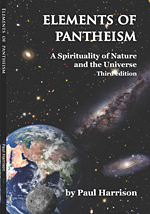The World Pantheist Movement has no plans to build churches or temples.
The real church of pantheism is Nature: the idea of retiring to darkened interiors
is alien to pantheism.
Pantheist groups most often meet in natural surroundings. In inclement weather, they meet in each others’ houses. If the group is too large for that, hiring would seem more sensible than devoting massive funds to a special building that remained empty most of the time.
What pantheist circles do is up to each circle. What follows below consists only of outline suggestions. Groups are perfectly free to create their own formats and topics.
The typical meeting could have various sections:
1. A shared exploration topic.
Exploring, discovering, and getting to know and love better the natural world and the universe.
Each week could be devoted to one theme, which might involve a field trip, bringing a natural object, exploring the elements, or pantheist ways of living. On indoor weeks one of the group would give a short talk on a different topic, not from a sophisticated scientific point of view, often perhaps just about the enthusiasm for natural form. The purpose is not just to understand the world, but to appreciate nature, ecosystems, natural form, as a way of reinforcing our feeling of unity and solidarity.
See Topics for the yearly cycle
2. A green living or social action topic or action.
- Treeplanting.
- Recycling.
- Cycling.
- Environmental restoration or conservation.
- Social action
3. Exercise, dance, Tai Chi etc.
- Music (natural sounds and rhythms, water, rain, whales, birds etc).
- Singing:
- eg Earth Prayers (ed. Elisabeth Roberts and Elias Amidon, Harper Collins San Francisco).
- Running or walking.
- Dance. Tai Chi.
- Awareness of gravity and body.
4. Ritual.
- Bonding circles.
- Laughing circles (where everyone lies on their backs with their head to the middle and starts laughing).
- Specific rituals connected with season and time of year.
- In general real ritual would be preferred over symbolic: real actions and real objects relate us more directly to nature and the universe than do symbolic ones.
- For example: Maypole, Xmas tree, pumpkin, egg, flame, water, communal meals are real natural examples but also symbols of the class of things they represent.
Ritual enactment of rites derived from other religions, such as fertility rites, are perfectly okay in line with the belief statement, but carry the same risk as symbolic polytheism does: that the participant may pay more attention to the symbol than to the meaning.
5. Reverence
Five minutes silent reverence, contemplating nature, tree hugging, or looking natural collected objects, eg, pebbles, bark, tree seeds.
6. Meditation
- Discussion of techniques for meditation, union and stress relief.
- Five minutes silent practice, connecting with one’s own material existence.

